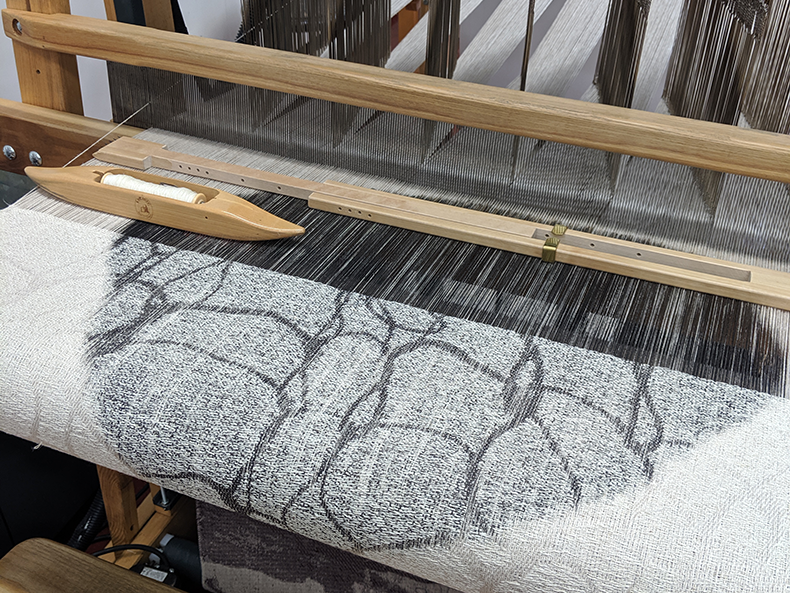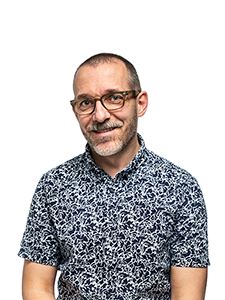Associate Professor, Fibre
School of Craft & Emerging Media, AUArts
AUArts Alum 1998, BFA | Textiles
AUArts: What do you do?
Mackenzie Kelly-Frère (MKF): I am a textile artist and teach people to weave and think through textiles. My fascination with the material culture of cloth and my passion for its potential as a tool for communication drive my work in the studio and in the classroom.
AUArts: And you are currently teaching Fibre here (AUArts)?
MKF: I teach in Fibre, and I also supervise graduate students. In Fibre, I teach weaving and senior studio classes, along with first-year classes.
AUArts: How is cloth a tool for communication and how did you get into it in the first place?
MKF: One of the reasons that I am excited to teach and work in textiles is that it offers the opportunity to look at something really familiar like cloth – it’s something that we wear every day. It's on our bodies all the time – I like to think about it as a tool for making meaning.
Like if your grandmother knits your sweater, it can mean care, even love. It's those kinds of things that are embedded in the material that I'm really interested in. Cloth also has connotations of the home, and provides kind of an analogue to our own body. It’s a second skin that we have with us all the time.
AUArts: So there are many metaphors for cloth.
MKF: I'm also thinking about the different ways in which textiles can provide a metaphor for entanglement and being interconnected – the mutual contingency of human experience. We are all relying on one another, probably now more than ever. And for me, textiles are just a particularly potent way to work through those ideas.

AUArts: So you’ve been studying in textiles, since you started at AUArts?
MKF: I took to textiles pretty much right away in my first year.
When you find your thing, you find your thing, right? I think I was drawn to the complexity. I fell in love with some of the processes. My interest in all the different aspects of textile practice came a little later. But certainly in our first and second year classes, it's all about material and technique and sort of bold exploration of those things.
AUArts: So, when you first started at AUArts, you didn't know that you were going to go into textiles?
MKF: Oh no, I planned to study Painting.
AUArts: Oh really?
MKF: Yes, but that is one of the great things about a broad first year experience like we have at AUArts. Students get to test out a variety of mediums and ways of making and ways of making meaning using different materials, different modes of communication and figure out what's good for them.
AUArts: What do you think sets the AUArts’ student experience apart from any other art school in Canada?
MKF: At AUArts you have very active professional artists, craftspeople, designers doing what they do. This means that students get to work with faculty who are actively engaged in what they hope to be doing in the future themselves.
So what sets us apart? One is the breadth of the program and the opportunity to try all different types of practice and modes of working.
And then you are also working alongside some pretty incredible professionals. I feel really lucky to work with the people I do every day. It’s a very lively intellectual and creative community because people don't necessarily all follow the same tune. There's a diversity of opinion that I think makes this place really exciting.
I feel really lucky to work with the people I do every day. It’s a very lively intellectual and creative community because people don't necessarily all follow the same tune. There's a diversity of opinion that I think makes this place really exciting.
AUArts: A much richer experience coming from different angles and different backgrounds.
MKF: Exactly. Folks are all really engaged in a community of creative practice. People really care about what they do around here. And I think that benefits our students greatly. My colleagues care about engaging with the students in a way that will make sense to them and that will be relevant to their lives and relevant to their own creativity. So I think that's really exciting.
AUArts: You mentioned that you teach in the graduate program. What makes the AUArts’ MFA program different?
MKF: There is a studio focus to the MFA Craft Media program that is genuinely student-led. They're encouraged to collaborate and co-create an environment where different approaches are all sort of thrown together. I think from an intellectual perspective, the ideas that are generated in that environment – where the ceramics graduate student is working on something with the textile graduate student – is pretty exciting.
Right now our cohorts are still really small, which also allows for a lot of one-on one-instruction with faculty, which is increasingly rare in other MFA programs. So you're getting a lot of individualized attention.
As well, we have a summer semester, in which the students really get to dig into the studio. They're not being asked to do other coursework at that time and are immersed in the studio exploration Which I think has been very valuable to the people that we've seen so far come through the program.
AUArts: How did you end up teaching at AUArts?
MKF: I was very interested in being able to return to AUArts as faculty, simply because of the community here. Are there other factors? I have family here. This is just my place. Some of my work is sometimes about this place. So being in Alberta made a lot of sense from that standpoint.
But I think what also drew me to pursue teaching at this particular place is that I know that I'm able to do the kind of teaching I want – the kind of fully engaged studio style of teaching that I know was really effective for me and helped to spark my own passion. So yeah, this is my place.

AUArts: What is your favourite part about being a professor at AUArts?
MKF: The opportunity to work with people at the beginning of their creative practice is something I never take for granted. I get to work in a place where people discover not only how to make, but ways to make meaning.
It’s super exciting to be there in the studio with someone when they figure something out. Whether they figure out, “This is my thing. I want to do this thing forever.” Or if they just figure out, “When I use a silk screen this way, it doesn't work very well.” Those are both really interesting times to be with someone. I feel lucky to teach and work with people at that stage of their creative practice.
AUArts: I'm sure it’s so rewarding to be able to witness their a-ha moments.
MKF: I think even more than that is when they figure out they can do something that they never thought they could, something that was highly technical or they had to really dig in and spend a lot of time on one project. In our programs, we try and give them that opportunity to really focus on an idea and really dig deep.
Of course other students will want to do the opposite of that. They're going to want to try a little bit of this or a little bit of that, testing all the waters. But for those who really want to dig in and focus on a discipline, that opportunity is here too.
AUArts: When you see the students from first year and fourth year, how do you see them growing?
MKF: One of the things that I hope that they'll have, is a capacity for curiosity and a what-if kind of mentality. “What if I do this?” or “What if I try that?”
They've tested some things out in the studio and gained a little bit of confidence. They know what they're passionate about.
I think what happens is, is they often will move from a simple curiosity to a much more complex curiosity that's informed by a broader knowledge of the design field, the art world or contemporary craft. And then they're able to ask harder questions, more engaged questions that are perhaps a lot harder to answer. That’s what I hope for them.
People talk a lot about lifelong learning. I think any kind of creative career pathway that someone will take involves a lot of adult learning. You know, when you're in your 40s, 50s, and 60s, because it's always changing, right?
The field into which you are bringing your work – whether it an exhibition or a magazine – you know that world is always changing. In order to stay current and stay engaged in the world you've got to keep working.
AUArts: If you had one piece of advice for new students thinking of coming to art school, what would it be?
MKF: Stay open. Try everything. Learn from each other.
I think the biggest obstacle that a lot of students face coming in first year is they have a clear idea of what they want to do. Whether it's been informed by an art teacher that they had, who said that you need to be a painter or you need to be a designer.
And they've decided already. Another way of saying it would be resist deciding, resist deciding on the path because the path might just find you. And if you stay open long enough, you’ll find something that really speaks to you.

AUArts: What do you enjoy about the AUArts community?
At its core, this is a community that values diversity and respect for difference. You will find evidence of this everywhere – particularly among our students, who inspire me every day with their ethic of care for one another, and the fearless honesty and passion in their work.
Among my colleagues and among the students, they're looking for all of those different viewpoints, right? Students are looking for viewpoints that don't match their own, just to encounter them, just to try and understand them.
At its core, this is a community that values diversity and respect for difference. You will find evidence of this everywhere – particularly among our students, who inspire me every day with their ethic of care for one another, and the fearless honesty and passion in their work.
When they ask their colleagues, why did you choose to talk about this theme in your work? Or why did you use that subject matter, that's really challenging? They want to know. And even when they don't understand one another, I see them struggle with it, ask the question a different way and try and get there.
For a new student coming to AUArts, they can feel safe and valued kind of no matter what their beliefs or backgrounds.
There's a space for them here. And I think increasingly, we're all working to make space for diversity in all its forms. I think there's a real emphasis these days to get it right and to make room for everyone.
instagram.com/mackenziekellyfrere
